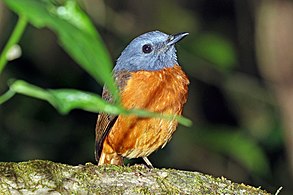Amber Mountain rock thrush
| Amber Mountain rock thrush | |
|---|---|

| |
| male, Montagne d'Ambre National Park | |
| Scientific classification | |
| Domain: | Eukaryota |
| Kingdom: | Animalia |
| Phylum: | Chordata |
| Class: | Aves |
| Order: | Passeriformes |
| Family: | Muscicapidae |
| Genus: | Monticola |
| Species: | M. erythronotus
|
| Binomial name | |
| Monticola erythronotus (Lavauden, 1929)
| |
| Synonyms | |
|
Pseudocossyphus erythronotus | |
The Amber Mountain rock thrush (Monticola erythronotus) is a songbird in the family Muscicapidae. It was formerly considered as a subspecies of the forest rock thrush (Monticola sharpei).
Distribution
[edit]The Amber Mountain rock thrush is endemic to Madagascar where it occurs only on the Amber Mountain massif in the north of the island.[1]
Description
[edit]This is a small forest-dwelling thrush, growing to a length of about 16 cm (6.3 in).[2] Males have blue hoods, chestnut upperparts, bright orange tail with brown central feathers and orange underparts. Females are mostly brown with an orange wash on the underparts and lack the blue hood. Males are distinguished from other rock-thrushes by the dark rufous back, while the females have bright orange tails and lack white streaking on the breast.[3]
Habitat and ecology
[edit]It inhabits mid-altitude and montane humid, evergreen forest from 800 to 1,300 m (2,600 to 4,300 ft), and forages inconspicuously in the understorey and on the ground, sometimes sallying to take aerial prey. The species nests in tree hollows or in crevices under overhangs.[1][2]
Conservation status
[edit]The Amber Mountain rock thrush is listed by the International Union for Conservation of Nature and Natural Resources as Endangered because it has a very small range and its forest habitat is declining in both area and quality. The population is small and believed to be declining, albeit slowly. The total population of this species is estimated to number less than 5,000 individuals, which occur in a single block of forest in the Amber Mountain National Park. It may be declining, although so far there has been relatively low levels of habitat loss in the area of its occurrence.[1]
Taxonomic notes
[edit]The Amber Mountain rock thrush has been regarded as a separate species but this view is in doubt. It had been split from the forest rock thrush because of a variety of morphological differences and in spite of an absence of genetic distinctiveness. As the forest rock thrush and Benson's rock thrush have been lumped into Monticola sharpei this taxon has followed suit.[1]
-
male
-
female
-
female
References
[edit]- ^ a b c d e BirdLife International (2016). "Monticola erythronotus". IUCN Red List of Threatened Species. 2016: e.T22730713A95029320. doi:10.2305/IUCN.UK.2016-3.RLTS.T22730713A95029320.en.
- ^ a b Collar, N. (2020). "Amber Mountain Rock-thrush (Monticola erythronotus)". Handbook of the Birds of the World Alive. Lynx Edicions, Barcelona. Retrieved 2 April 2020.
- ^ "Amber Mountain Rock-thrush Monticola erythronotus". Birdlife International. Retrieved 19 Jan 2015.
- Cruaud, A.; Raherilalao, M. J.; Pasquet, E.; Goodman, S. M. (2011). "Phylogeography and systematics of the Malagasy rock-thrushes (Muscicapidae, Monticola)" (PDF). Zoologica Scripta. 40 (6): 554–566. doi:10.1111/j.1463-6409.2011.00497.x. S2CID 83835660. Archived from the original (PDF) on 2020-04-04.




